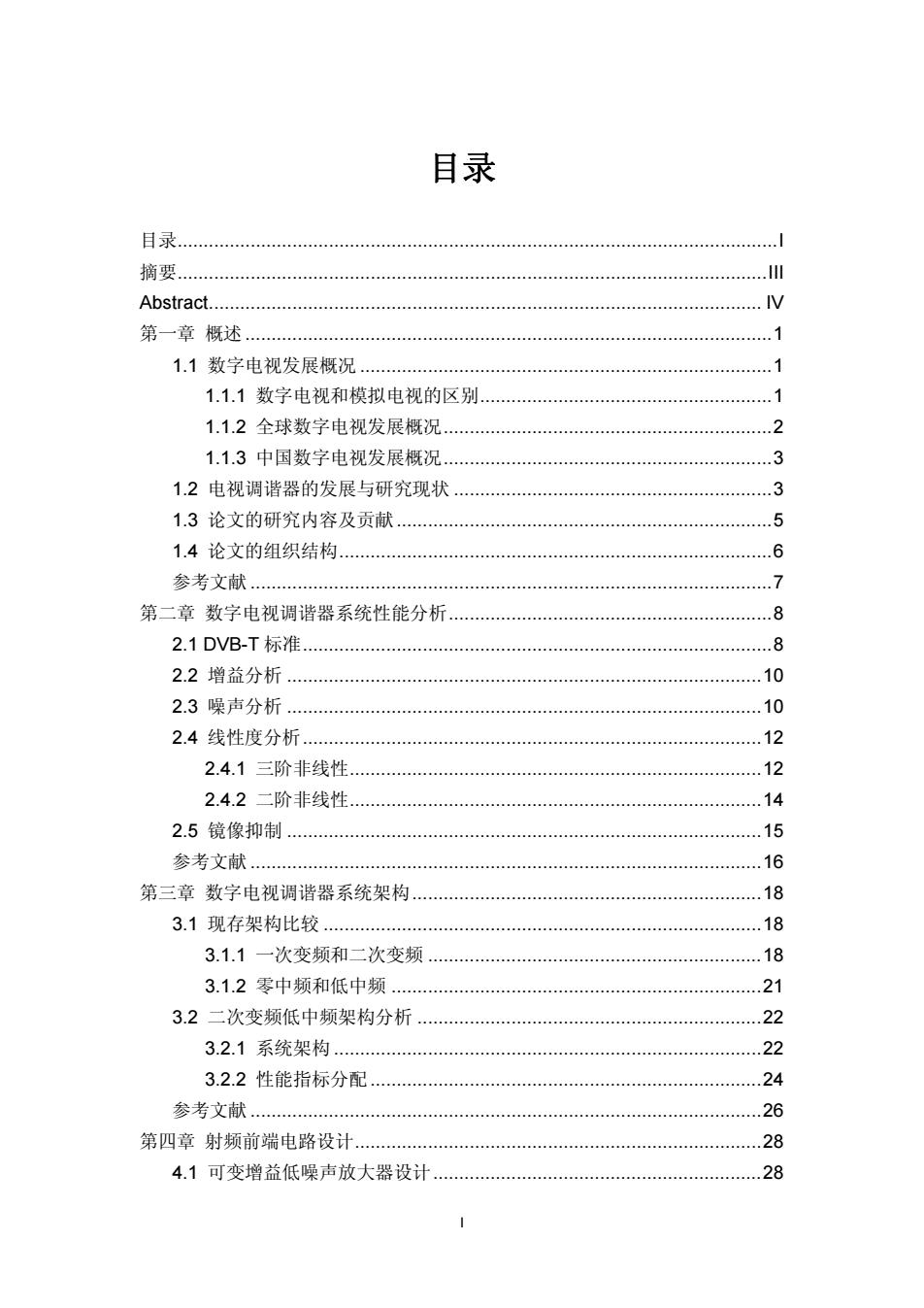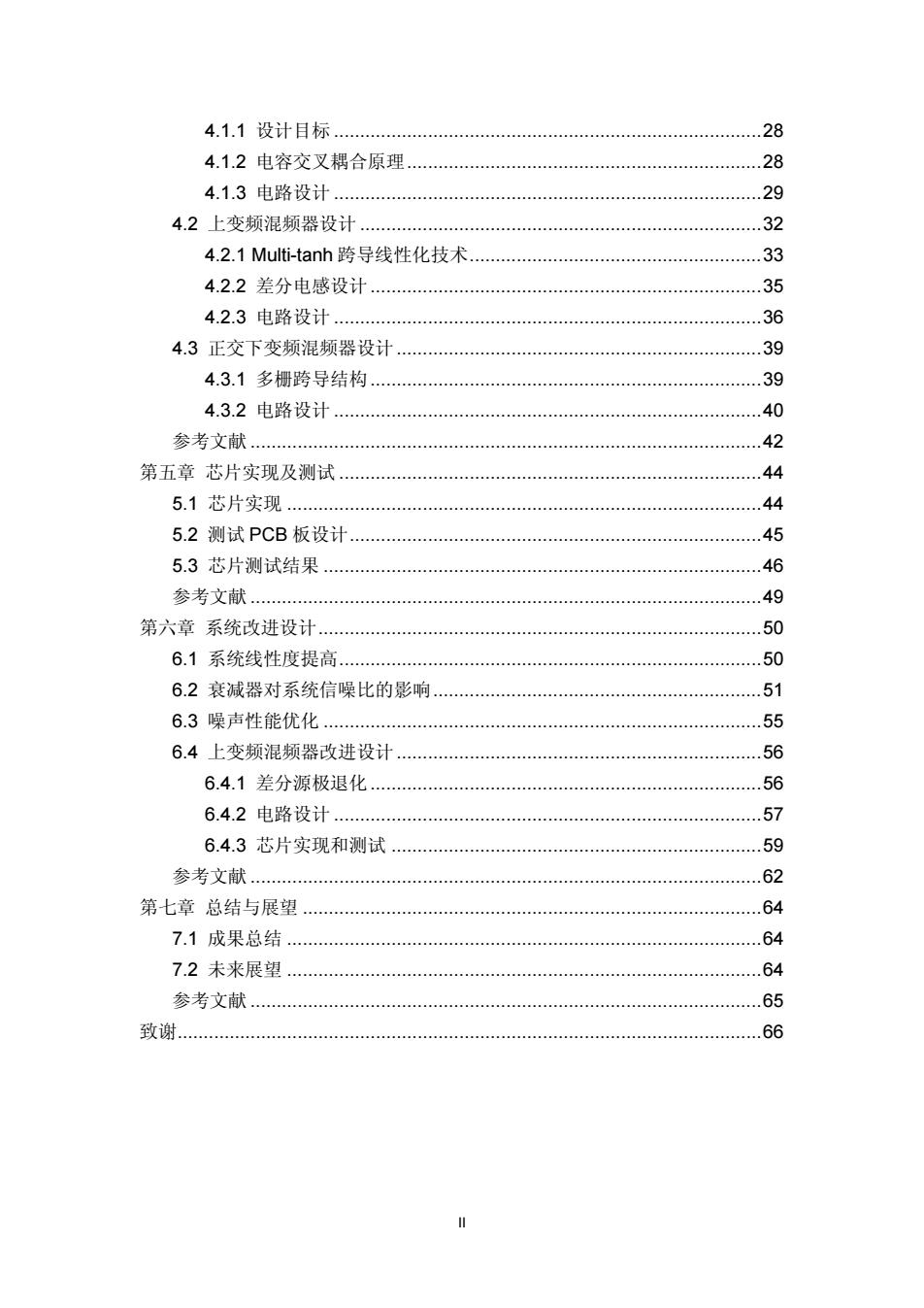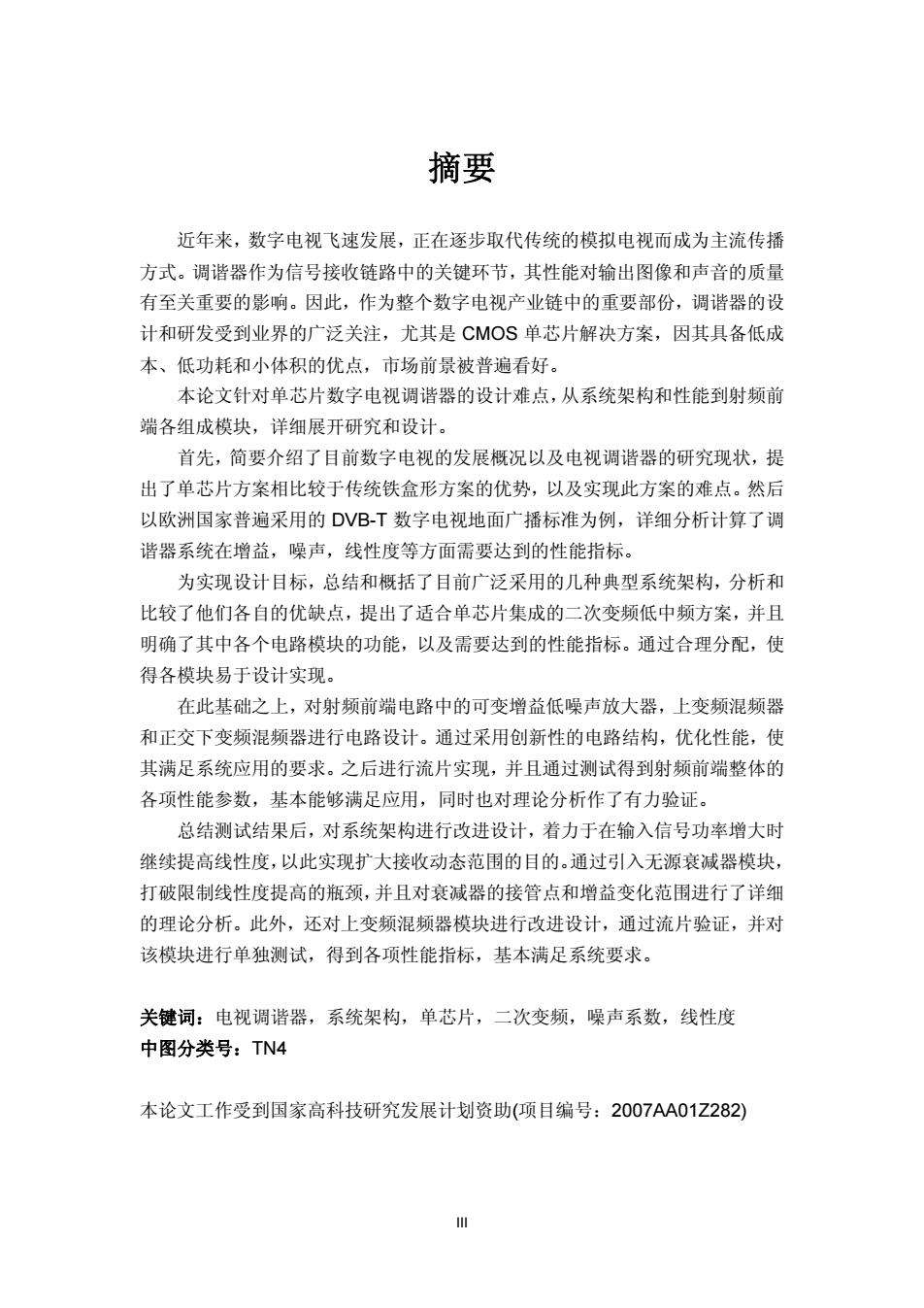
学校代码:10246 学号:052021071 復大婴 硕士学位论文 单芯片数字电视调谐器射频前端系统分析与设计 院 系: 微电子学系 专 业: 微电子学与固体电子学 姓 名:金黎明 指导教师: 唐长文副教授 完成日期: 2008年4月25日
学校代码: 10246 学 号: 052021071 硕 士 学 位 论 文 单芯片数字电视调谐器射频前端系统分析与设计 院 系: 微电子学系 专 业: 微电子学与固体电子学 姓 名: 金黎明 指 导 教 师: 唐长文 副教授 完 成 日 期: 2008 年 4 月 25 日

目录 目录 摘要 Abstract... IV 第一章概述 1 1.1数字电视发展概况… ·7 1.1.1数字电视和模拟电视的区别. 1 1.1.2全球数字电视发展概况… 2 1.1.3中国数字电视发展概况. 3 1.2电视调谐器的发展与研究现状 3 1.3论文的研究内容及贡献… 5 1.4论文的组织结构. 6 参考文献… 第二章数字电视调谐器系统性能分析 8 2.1DVB-T标准 2.2增益分析 0 2.3噪声分析 10 2.4线性度分析 .12 2.4.1三阶非线性 .12 2.4.2二阶非线性 .14 2.5镜像抑制 .15 参考文献 16 第三章数字电视调谐器系统架构 .18 3.1现存架构比较 ..18 3.1.1一次变频和二次变频 .18 3.1.2零中频和低中频 21 3.2二次变频低中频架构分析 22 3.2.1系统架构.… 22 3.2.2性能指标分配 24 参考文献..… 26 第四章射频前端电路设计...… 28 4.1可变增益低噪声放大器设计 28
I 目录 目录...................................................................................................................I 摘要.................................................................................................................III Abstract.......................................................................................................... IV 第一章 概述.....................................................................................................1 1.1 数字电视发展概况 ...............................................................................1 1.1.1 数字电视和模拟电视的区别........................................................1 1.1.2 全球数字电视发展概况...............................................................2 1.1.3 中国数字电视发展概况...............................................................3 1.2 电视调谐器的发展与研究现状 .............................................................3 1.3 论文的研究内容及贡献........................................................................5 1.4 论文的组织结构...................................................................................6 参考文献 ....................................................................................................7 第二章 数字电视调谐器系统性能分析..............................................................8 2.1 DVB-T 标准..........................................................................................8 2.2 增益分析 ...........................................................................................10 2.3 噪声分析 ...........................................................................................10 2.4 线性度分析........................................................................................12 2.4.1 三阶非线性...............................................................................12 2.4.2 二阶非线性...............................................................................14 2.5 镜像抑制 ...........................................................................................15 参考文献 ..................................................................................................16 第三章 数字电视调谐器系统架构...................................................................18 3.1 现存架构比较 ....................................................................................18 3.1.1 一次变频和二次变频 ................................................................18 3.1.2 零中频和低中频 .......................................................................21 3.2 二次变频低中频架构分析 ..................................................................22 3.2.1 系统架构 ..................................................................................22 3.2.2 性能指标分配...........................................................................24 参考文献 ..................................................................................................26 第四章 射频前端电路设计..............................................................................28 4.1 可变增益低噪声放大器设计...............................................................28

4.1.1设计目标 28 4.1.2电容交叉耦合原理 28 4.1.3电路设计.. 29 4.2上变频混频器设计 32 4.2.1Muti-tanh跨导线性化技术 33 4.2.2差分电感设计.... 35 4.2.3电路设计 36 4.3正交下变频混频器设计 39 4.3.1多栅跨导结构 39 4.3.2电路设计.. 40 参考文献 42 第五章芯片实现及测试 44 5.1芯片实现 44 5.2测试PCB板设计 45 5.3芯片测试结果 46 参考文献 49 第六章系统改进设计 50 6.1系统线性度提高.… 50 6.2衰减器对系统信噪比的影响 51 6.3噪声性能优化 55 6.4上变频混频器改进设计 56 6.4.1差分源极退化 56 6.4.2电路设计... 57 6.4.3芯片实现和测试 59 参考文献 62 第七章总结与展望 64 7.1成果总结 64 7.2未来展望 64 参考文献 65 致谢. 66
II 4.1.1 设计目标 ..................................................................................28 4.1.2 电容交叉耦合原理....................................................................28 4.1.3 电路设计 ..................................................................................29 4.2 上变频混频器设计 .............................................................................32 4.2.1 Multi-tanh 跨导线性化技术........................................................33 4.2.2 差分电感设计...........................................................................35 4.2.3 电路设计 ..................................................................................36 4.3 正交下变频混频器设计......................................................................39 4.3.1 多栅跨导结构...........................................................................39 4.3.2 电路设计 ..................................................................................40 参考文献 ..................................................................................................42 第五章 芯片实现及测试 .................................................................................44 5.1 芯片实现 ...........................................................................................44 5.2 测试 PCB 板设计...............................................................................45 5.3 芯片测试结果 ....................................................................................46 参考文献 ..................................................................................................49 第六章 系统改进设计.....................................................................................50 6.1 系统线性度提高.................................................................................50 6.2 衰减器对系统信噪比的影响...............................................................51 6.3 噪声性能优化 ....................................................................................55 6.4 上变频混频器改进设计......................................................................56 6.4.1 差分源极退化...........................................................................56 6.4.2 电路设计 ..................................................................................57 6.4.3 芯片实现和测试 .......................................................................59 参考文献 ..................................................................................................62 第七章 总结与展望 ........................................................................................64 7.1 成果总结 ...........................................................................................64 7.2 未来展望 ...........................................................................................64 参考文献 ..................................................................................................65 致谢................................................................................................................66

摘要 近年来,数字电视飞速发展,正在逐步取代传统的模拟电视而成为主流传播 方式。调谐器作为信号接收链路中的关键环节,其性能对输出图像和声音的质量 有至关重要的影响。因此,作为整个数字电视产业链中的重要部份,调谐器的设 计和研发受到业界的广泛关注,尤其是CMOS单芯片解决方案,因其具备低成 本、低功耗和小体积的优点,市场前景被普遍看好。 本论文针对单芯片数字电视调谐器的设计难点,从系统架构和性能到射频前 端各组成模块,详细展开研究和设计。 首先,简要介绍了目前数字电视的发展概况以及电视调谐器的研究现状,提 出了单芯片方案相比较于传统铁盒形方案的优势,以及实现此方案的难点。然后 以欧洲国家普遍采用的DVB-T数字电视地面广播标准为例,详细分析计算了调 谐器系统在增益,噪声,线性度等方面需要达到的性能指标。 为实现设计目标,总结和概括了目前广泛采用的几种典型系统架构,分析和 比较了他们各自的优缺点,提出了适合单芯片集成的二次变频低中频方案,并且 明确了其中各个电路模块的功能,以及需要达到的性能指标。通过合理分配,使 得各模块易于设计实现。 在此基础之上,对射频前端电路中的可变增益低噪声放大器,上变频混频器 和正交下变频混频器进行电路设计。通过采用创新性的电路结构,优化性能,使 其满足系统应用的要求。之后进行流片实现,并且通过测试得到射频前端整体的 各项性能参数,基本能够满足应用,同时也对理论分析作了有力验证。 总结测试结果后,对系统架构进行改进设计,着力于在输入信号功率增大时 继续提高线性度,以此实现扩大接收动态范围的目的。通过引入无源衰减器模块, 打破限制线性度提高的瓶颈,并且对衰减器的接管点和增益变化范围进行了详细 的理论分析。此外,还对上变频混频器模块进行改进设计,通过流片验证,并对 该模块进行单独测试,得到各项性能指标,基本满足系统要求。 关键词:电视调谐器,系统架构,单芯片,二次变频,噪声系数,线性度 中图分类号:TN4 本论文工作受到国家高科技研究发展计划资助(项目编号:2007AA01Z282)
III 摘要 近年来,数字电视飞速发展,正在逐步取代传统的模拟电视而成为主流传播 方式。调谐器作为信号接收链路中的关键环节,其性能对输出图像和声音的质量 有至关重要的影响。因此,作为整个数字电视产业链中的重要部份,调谐器的设 计和研发受到业界的广泛关注,尤其是 CMOS 单芯片解决方案,因其具备低成 本、低功耗和小体积的优点,市场前景被普遍看好。 本论文针对单芯片数字电视调谐器的设计难点,从系统架构和性能到射频前 端各组成模块,详细展开研究和设计。 首先,简要介绍了目前数字电视的发展概况以及电视调谐器的研究现状,提 出了单芯片方案相比较于传统铁盒形方案的优势,以及实现此方案的难点。然后 以欧洲国家普遍采用的 DVB-T 数字电视地面广播标准为例,详细分析计算了调 谐器系统在增益,噪声,线性度等方面需要达到的性能指标。 为实现设计目标,总结和概括了目前广泛采用的几种典型系统架构,分析和 比较了他们各自的优缺点,提出了适合单芯片集成的二次变频低中频方案,并且 明确了其中各个电路模块的功能,以及需要达到的性能指标。通过合理分配,使 得各模块易于设计实现。 在此基础之上,对射频前端电路中的可变增益低噪声放大器,上变频混频器 和正交下变频混频器进行电路设计。通过采用创新性的电路结构,优化性能,使 其满足系统应用的要求。之后进行流片实现,并且通过测试得到射频前端整体的 各项性能参数,基本能够满足应用,同时也对理论分析作了有力验证。 总结测试结果后,对系统架构进行改进设计,着力于在输入信号功率增大时 继续提高线性度,以此实现扩大接收动态范围的目的。通过引入无源衰减器模块, 打破限制线性度提高的瓶颈,并且对衰减器的接管点和增益变化范围进行了详细 的理论分析。此外,还对上变频混频器模块进行改进设计,通过流片验证,并对 该模块进行单独测试,得到各项性能指标,基本满足系统要求。 关键词:电视调谐器,系统架构,单芯片,二次变频,噪声系数,线性度 中图分类号:TN4 本论文工作受到国家高科技研究发展计划资助(项目编号:2007AA01Z282)

Abstract Digital Television has been developed rapidly,and is gradually replacing the traditional analog TV in recent years.The TV tuner,whose performance strongly determines the quality of the output audio and video,takes an important role in the DTV industry.As a result,many institutes have been engaged in the tuner design and other related research work,especially in the CMOS single-chip solution due to its advantages including low cost,low power and small size. This work presents the analysis and design of the tuner architecture specification,and build-up modules,with an eye to the difficulties in the single-chip integration. Firstly,an overview about the development of the DTV and tuner is provided. And the specification of the tuner is theoretically analyzed such as gain,noise figure and linearity,taking European DVB-T standard for an example. Secondly,the double conversion low IF architecture is introduced based on the comparison of the current popular architectures.The specification of the build-up modules is carefully distributed to make them easy to design. The RF front-end circuits of the tuner,including the variable gain low noise amplifier (VGLNA),the upconversion mixer,and the quadrature downconversion mixer are designed and then taped out.The measurement results verify the theoretical analysis. Finally,the tuner architecture is improved by exploiting a passive attenuator,to achieve better linearity,leading to larger dynamic range.The take-over point and the variable gain range are analyzed.In addition,a modified upconversion mixer is presented and taped out.The measurement results show the performance of the mixer satisfies the demands of the whole system. Key word:TV tuner,architecture,single-chip,double conversion,noise figure,linearity This project is supported by the National High Technology Research and Development Program of China(No.2007AA01Z282). W
IV Abstract Digital Television has been developed rapidly, and is gradually replacing the traditional analog TV in recent years. The TV tuner, whose performance strongly determines the quality of the output audio and video, takes an important role in the DTV industry. As a result, many institutes have been engaged in the tuner design and other related research work, especially in the CMOS single-chip solution due to its advantages including low cost, low power and small size. This work presents the analysis and design of the tuner architecture, specification, and build-up modules, with an eye to the difficulties in the single-chip integration. Firstly, an overview about the development of the DTV and tuner is provided. And the specification of the tuner is theoretically analyzed such as gain, noise figure and linearity, taking European DVB-T standard for an example. Secondly, the double conversion low IF architecture is introduced based on the comparison of the current popular architectures. The specification of the build-up modules is carefully distributed to make them easy to design. The RF front-end circuits of the tuner, including the variable gain low noise amplifier (VGLNA), the upconversion mixer, and the quadrature downconversion mixer are designed and then taped out. The measurement results verify the theoretical analysis. Finally, the tuner architecture is improved by exploiting a passive attenuator, to achieve better linearity, leading to larger dynamic range. The take-over point and the variable gain range are analyzed. In addition, a modified upconversion mixer is presented and taped out. The measurement results show the performance of the mixer satisfies the demands of the whole system. Key word: TV tuner, architecture, single-chip, double conversion, noise figure, linearity This project is supported by the National High Technology Research and Development Program of China (No. 2007AA01Z282)